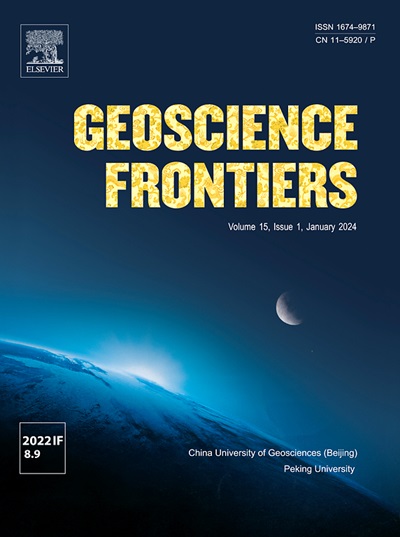Toxic impacts of polystyrene nanoplastics and PCB77 in blunt snout bream: Evidence from tissue morphology, oxidative stress and intestinal microbiome
IF 8.9
1区 地球科学
Q1 GEOSCIENCES, MULTIDISCIPLINARY
引用次数: 0
Abstract
Polystyrene nanoplastics (PS-NPs) and 3,3′,4,4′-tetrachlorobiphenyl (PCB77) are common pollutants in freshwater aquatic environments. To investigate the separate and combined toxicity of these two pollutants on the freshwater blunt snout bream (Megalobrama amblycephala), 270 juveniles were randomly assigned to six exposure treatments: the control group, CT (free of PS-NPs and PCB77), three single exposure groups, PS-L (0.2 mg/L PS-NPs), PS-H (2 mg/L PS-NPs), PCB (0.01 mg/L PCB77), and two combined exposure groups, PP-L (0.2 mg/L PS-NPs + 0.01 mg/L PCB77) and PP-H (2 mg/L PS-NPs + 0.01 mg/L PCB77). After a seven-day exposure, the tissue histopathology, antioxidant capacity, inflammatory response, and gut microbiome composition of fish were analyzed. The results showed that tissue fluorescence intensity of PS-NPs increases as the exposure levels of PS-NPs increase, and the combined exposure groups exhibited higher fluorescence intensity compared to their single PS-NPs exposure groups. Histopathological analysis showed that the exposure groups exhibited varying degrees of damage to the intestinal tissue compared to the control group, with more severe damage observed in the combined exposure groups. Additionally, liver damage was evident in the PS-H, PP-L and PP-H groups. Furthermore, the highest catalase (CAT) activities and malondialdehyde (MDA) contents were found in the intestine and liver of fish in the PP-L and PP-H groups. The mRNA levels of inflammatory factors (il, il-1β, il-8, il-6, il-10, and tnf-α) were up-regulated in the PS-H, PP-L and PP-H groups compared to those of the CT group. In addition, remarkable alternations in the intestinal microbiome compositions were observed among the groups: the abundance of Verrucomicrobiome and Planctomycetota increased in all exposed groups compared to that of the control group, while the abundance of Actinobacteriota was significantly reduced in the exposure groups. Functional prediction of microbiota indicated that the amino acid and carbohydrate metabolism, as well as intestinal structure, were impaired in the PS-NPs and PCB77 exposure groups. The results suggested that the toxicity of PS-NPs on M. amblycephala including tissue injury, oxidative stress, and disturbance of intestinal microbiota, depends not only on concentration but also increases when co-exposed to PCB77. This finding raises concerns about the ecological safety in freshwater aquatic environments.

聚苯乙烯纳米塑料和PCB77对钝口鲷的毒性影响:来自组织形态、氧化应激和肠道微生物组的证据
聚苯乙烯纳米塑料(PS-NPs)和3,3 ',4,4 ' -四氯联苯(PCB77)是淡水水生环境中常见的污染物。为了研究这两种污染物对淡水鳙鱼(Megalobrama amblycephala)的单独和联合毒性,将270只幼鱼随机分为6个暴露处理:对照组、CT(不含PS-NPs和PCB77)、3个单一暴露组,PS-L (0.2 mg/L PS-NPs)、PS-H (2 mg/L PS-NPs)、PCB (0.01 mg/L PCB77)、PP-L (0.2 mg/L PS-NPs + 0.01 mg/L PCB77)和PP-H (2 mg/L PS-NPs + 0.01 mg/L PCB77)。暴露7天后,对鱼的组织病理学、抗氧化能力、炎症反应和肠道微生物组组成进行了分析。结果表明,PS-NPs的组织荧光强度随PS-NPs暴露水平的增加而增加,且联合暴露组的荧光强度高于单独暴露组。组织病理学分析显示,与对照组相比,暴露组对肠道组织的损伤程度不同,联合暴露组的损伤更为严重。此外,PS-H、PP-L和PP-H组均有明显的肝损害。此外,PP-L和PP-H组鱼的肠道和肝脏过氧化氢酶(CAT)活性和丙二醛(MDA)含量最高。与CT组比较,PS-H、PP-L、PP-H组炎症因子il、il-1β、il-8、il-6、il-10、tnf-α mRNA水平均上调。此外,各组肠道微生物组的组成也发生了显著变化:与对照组相比,所有暴露组的Verrucomicrobiome和Planctomycetota的丰度都有所增加,而放线菌群的丰度在暴露组中显著降低。微生物群的功能预测表明,PS-NPs和PCB77暴露组的氨基酸和碳水化合物代谢以及肠道结构受到损害。结果表明,PS-NPs对双头棘球蚴的毒性包括组织损伤、氧化应激和肠道菌群紊乱,不仅与浓度有关,而且与PCB77共暴露时毒性增加。这一发现引起了人们对淡水水生环境生态安全的关注。
本文章由计算机程序翻译,如有差异,请以英文原文为准。
求助全文
约1分钟内获得全文
求助全文
来源期刊

Geoscience frontiers
Earth and Planetary Sciences-General Earth and Planetary Sciences
CiteScore
17.80
自引率
3.40%
发文量
147
审稿时长
35 days
期刊介绍:
Geoscience Frontiers (GSF) is the Journal of China University of Geosciences (Beijing) and Peking University. It publishes peer-reviewed research articles and reviews in interdisciplinary fields of Earth and Planetary Sciences. GSF covers various research areas including petrology and geochemistry, lithospheric architecture and mantle dynamics, global tectonics, economic geology and fuel exploration, geophysics, stratigraphy and paleontology, environmental and engineering geology, astrogeology, and the nexus of resources-energy-emissions-climate under Sustainable Development Goals. The journal aims to bridge innovative, provocative, and challenging concepts and models in these fields, providing insights on correlations and evolution.
文献相关原料
公司名称
产品信息
阿拉丁
PCB77
 求助内容:
求助内容: 应助结果提醒方式:
应助结果提醒方式:


